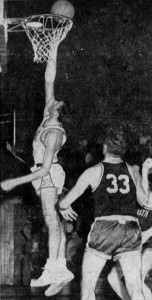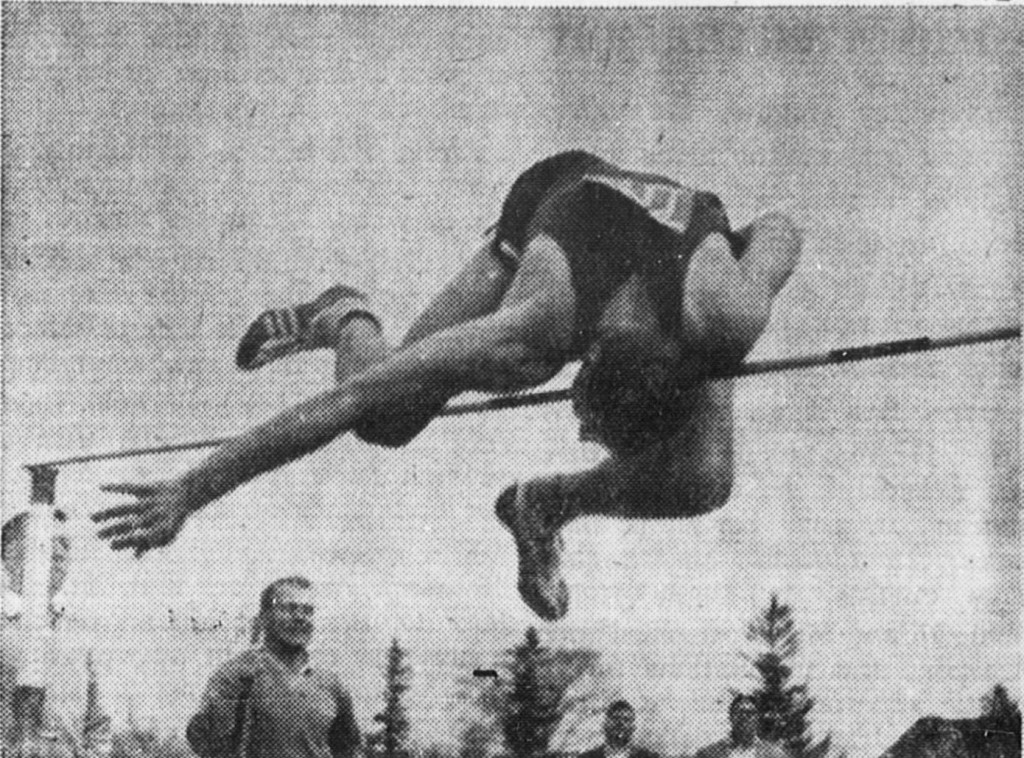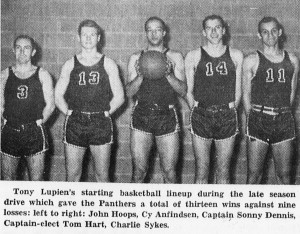
Those who watched Tom Hart became accustomed with this image: Hart grabbing an offensive rebound and converting the putback.
Tom Hart ’56 graduated as one of the most decorated players in Middlebury basketball history. During his three year career as a Panther, Hart set the all-time school rebounding record, as well as the single-season NCAA record for rebounds during the 1956 season when the 6’4” forward averaged 29.5 rebounds per game. Both the school mark and the NCAA record still stand to this day. Hart was drafted into the army a month after graduating from Middlebury and stayed overseas to play professional basketball in Germany before returning back to the US to enjoy a professional basketball career before working in “corporate America” as he says.
DH: Did you know anything about the basketball team at Middlebury before you went there?
TH: No, I didn’t know anything. I knew basketball schools like North Carolina and Kentucky — basketball machines.
DH: What was Tony Lupien like as a head coach and how was he able to bring such talented players such as yourself, Sonny Dennis and Charlie Sykes to Middlebury?
TH: He was not that great on Xs and Os, but he was a tremendous seller of the program and a master of getting the most out of every athlete he had. He instilled a sense of pride in the team and in the school. He was just a great motivator.
DH: Zip Rausa told me about a game when you took a particularly long shot — he said it was a 15-footer — that coach Lupien was pleading from the bench that you wouldn’t take. Do you remember that story?
TH: There were probably a couple of them, but I do remember one in particular. I was all geared up to take a 15-foot hook shot, and I hear from the bench, “Don’t do it, Tom!”
DH: That’s exactly the story that Zip Rausa told me. He also told me you made the shot.
TH: That I don’t remember. [Laughs] I just remember worrying about getting pulled from the game because I took the shot. But it’s possible — probably a one out of ten chance — I was never a great shooter.
DH: Back in the 50’s how did athletics fit within the overall academic mission of the College and what was the relationship like between athletic programs, specifically the basketball team, and the student body?
TH: Even though Middlebury basketball in the mid-50’s was making its place on the map, ninety-eight percent of the College was still to graduate the student-athletes.
DH: Which teammates will you remember most playing with from that era?
TH: I would have to say John Hoops.
DH: And what about John Hoops?
TH: He was just a little guy, 5’8’’ or whatever and he made a tremendous contribution to the overall team effort. [He was] a very good passer, he had a keen eye for hitting the open man, played good defense and obviously loved the game.
DH: Can you speak a little bit about what Sonny Dennis was like as a player and then as well what he was like as a teammate and a person?
TH: Sonny was a free spirit. Some of my teammates may disagree, [but] I don’t think he was a great “athlete.” But he made the most of what talent God had given him and when he was on the court he was very focused, not aware of the crowd, didn’t play to the crowd, played a team game.
Sonny avoided the army, I was not that lucky. A month after I graduated, in ’56 — one month to the day — I was in the army for two years and played basketball overseas in Germany.
DH: What are some of the stories from the road trips that stand out in your mind — the times with your teammates?
TH: One of my most outstanding remembrances was that it didn’t make any difference where we were driving to a game, we’d stop at a gas station or a convenience store and everybody knew Tony, no matter where we were. Even in the arctic tundra of extreme northern New York state we would stop at some little gas station and the owner would come out and give him a hug and say, “How ya been, Tony?” It was unbelievable.
DH: What moments, games or accolades stand out now from your Middlebury career?
TH: Well I guess I have to speak selfishly. It would be the night that we played UVM at UVM and it was freezing cold outside. About an hour and a half before we were supposed to hit the gymnasium and we were in this old, raggedy hotel and the heat was unbelievable in this relatively small room. I guess I nodded off because the next thing I remember someone shook me and said, “Come on, we have to get on the bus.” And I said, “Oh boy, sleeping just before a game? Las time I did not play well.” And as a matter of fact that was the night when I had 36 points and 36 rebounds in that game.
DH: Is that the game when you barely beat UVM? And is that also the game when Sonny Dennis made two free throws in the final minute to give [Middlebury] the lead?
TH: Yes, exactly. I remember it vividly — [Sonny] was on the foul line and we were down one with seconds to go. I was standing on the foul line, just praying he would make at least one so we could go to overtime. [The shot] rattled around a little, but it went in the hole and I remember I took the biggest vertical jump I’ve ever had in my history when that shot went in the hoop.
DH: Can you talk about the success of your teams when you were playing on the court with Sonny Dennis and Charlie Sykes and the transformation from Middlebury basketball teams that won a couple of games every year to having a winning season?
TH: Sonny, as you probably know was there a year before me, and his presence his freshman year brought a lot more interest than Middlebury ever paid to the basketball [team]. So through him they developed a following, I got there a year later, and had a fair amount of success my freshman year. All of a sudden the stands were getting filled and the cheering was almost raucous — it was quite a transformation.
DH: How close have you stayed to the program since you graduated, and in your eyes what’s the biggest difference between basketball at Middlebury in the 1950s and basketball at Middlebury today?
TH: Unfortunately I’ve only seen one or two Middlebury games since I graduated, but I can speak generically for basketball across the country. People ask me a lot when they find out when I played pro ball, “What’s the big difference in basketball today versus the 50s?” The obvious [answer] to me is that the game is still played between the end zones, so to speak. You take the ball out, the goal is to get down the court safely, work a play, get the best shot, make it, and so forth — that’s the vanilla part of the game and that of course still exists. But, having said that, I’ve been to some professional games even recently and it just flabbergasts me the way the game has changed from the standpoint of the size. Not only is 6’8’’, 6’9’’, 6’10’’, even 7’0’’ fairly commonplace, but to go with their height, the majority of them have a good amount of weight that’s all muscle, mostly, and their blessed with the physicality of a six-footer, and that’s what’s amazing to me. And the amount of contact that the referees now allow, even in the college game, is very interesting.

Hart preferred the individual nature of track and field events, where he specialized largely in jumping exercises, such as the high jump here.
DH: What were you able to take from your basketball career at Middlebury in your post-college career, both in pro basketball and beyond?
TH: I think it was very beneficial towards my post-Middlebury years. There’s so much more to team sports than just winning games or losing games — it’s the camaraderie, but it also teaches you how to take a step back, not only on the basketball floor, but also in life itself, and how to work with others —the whole experience of working with others to meet a common goal.
DH: When you look back at your time at Middlebury now, is there any one thing that stands out particularly in your mind?
TH: Absolutely, and it’s not good. Because I had four years of prep school, when I finally got to Middlebury and I had all this freedom I didn’t know how to handle it, and subsequently I flunked out my freshman year and lost a whole year of Middlebury basketball, so it’s a negative.
I would just add to that, surprisingly I actually enjoyed track more than I enjoyed basketball. I ran seven events every meet and it was just me, just individual — you make it on your own or you lose it on your own, and that appealed to me in track, and I was blessed with a fair amount of talent.
DH: Is there anything else you’d like to add?
TH: I had a fair successful career in corporate America and I attribute about ninety-eight percent of that to my Middlebury career.

